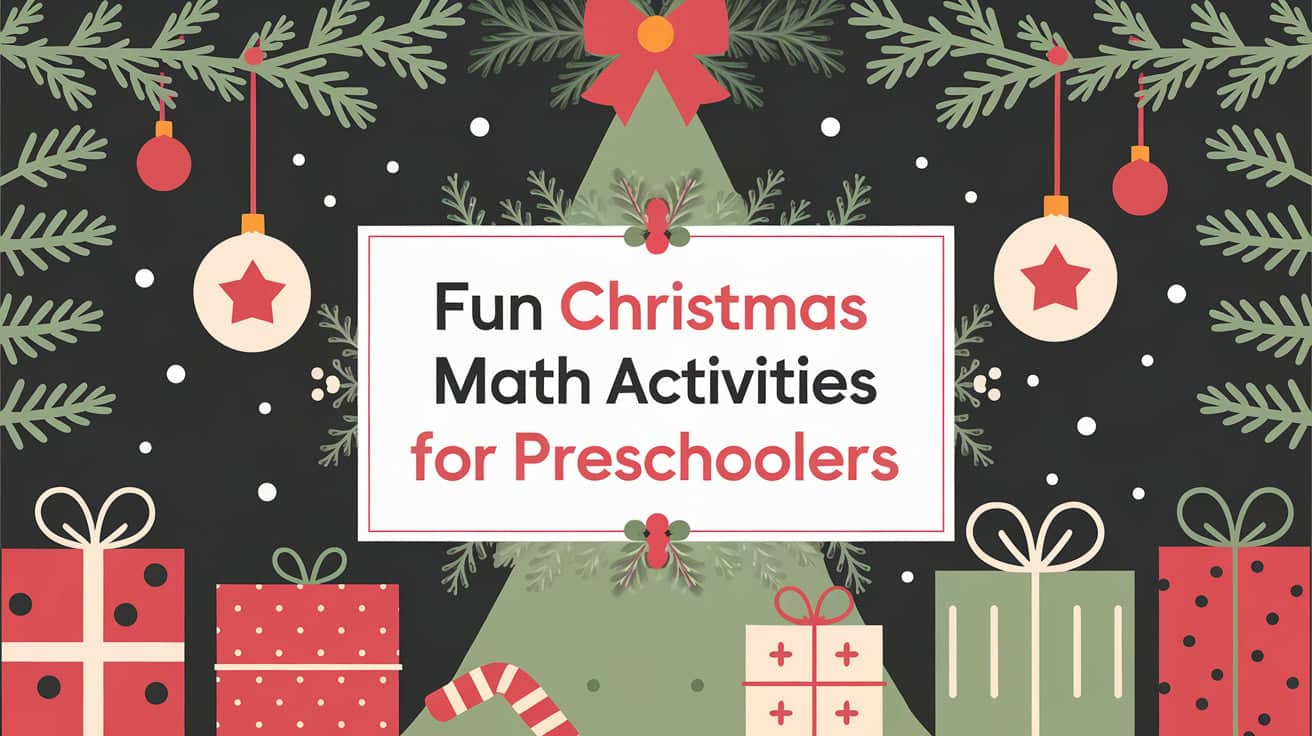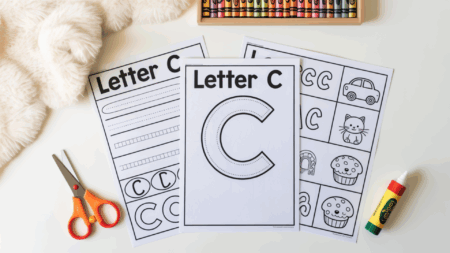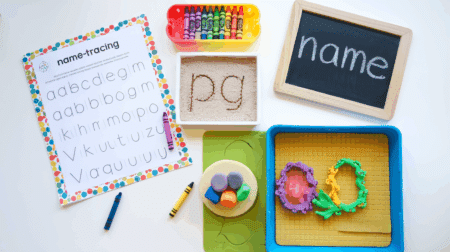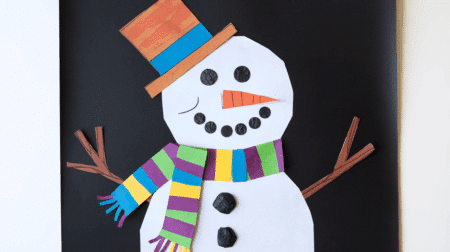Want to make math fun this Christmas? Preschoolers love the season, and it’s the perfect time to bring in some learning, too.
Using colors, candy, trees, and lights, you can turn everyday math into something exciting.
These Christmas math activities for preschoolers are engaging, hands-on, and perfectly suited for little learners. They’ll count, sort, match, and solve problems without even realizing they’re learning.
In this blog, you’ll see easy-to-follow Christmas math ideas and games that help kids learn while having fun.
Christmas Math Activities for Preschoolers
Make learning fun this holiday season with these easy math games. These activities utilize Christmas themes to help children learn while playing at the same time.
Basic Activities (Ages 2-4)
1. Christmas Tree Counting

This activity helps children practice counting and number recognition using a festive Christmas tree theme.
Provide each child with a printable Christmas tree mat and a collection of small counters like buttons, pom-poms, or mini ornaments. Label each tree with a number from 1-10. The children must count and place the correct number of ornaments on each tree.
For added difficulty, you can color-code the trees and counters, requiring children to match both number and color. This hands-on activity reinforces one-to-one correspondence while developing fine motor skills in a seasonal context.
2. Candy Cane Number Recognition

Transform number recognition into a sweet holiday game with candy cane-themed cards.
Create printable candy canes with varying numbers of red stripes (1-10) and corresponding number cards. Children must examine each candy cane, count the stripes, and match it with the correct number card.
For an interactive version, use real mini candy canes arranged in numbered groups. This activity strengthens counting skills and number identification. The visual pattern of the candy cane stripes also helps children develop subitizing skills as they begin to recognize quantities without counting each stripe.
3. Gingerbread House Patterns

Develop pattern recognition skills with colorful gingerbread house worksheets.
Provide children with printable gingerbread house outlines and various decorations, such as colored stickers, dot markers, or cut-out paper shapes. Start by demonstrating simple patterns, such as AB (red-green) or ABC (red-green-white), along the roofline or walls of the house. Children then continue or create their patterns to decorate their homes.
This activity introduces mathematical pattern concepts through artistic expression, enabling children to observe how patterns create visual rhythm while developing their logical thinking skills.
4. Santa’s Addition Challenge

Make early addition fun with this Santa-themed math activity.
Create worksheets featuring Santa’s image with simple addition problems (sums to 5) on his hat, beard, or gift sack. Children can use small counters or draw dots to help solve each equation. For a more interactive approach, create a magnetic Santa face where children can place the correct number of “snowball” magnets on his beard to solve addition problems.
This playful introduction to addition helps children understand the concept of combining quantities while associating positive feelings with mathematical problem-solving.
5. M&M Christmas Tree Math Activity

This tasty math activity combines counting, color sorting, and following directions.
Create printable Christmas tree templates featuring colored circles and numbers that indicate the number of M&Ms (or other colored candies) to place in each section. For example, “Put 3 red M&Ms on the top of the tree” or “Place 5 green candies on the bottom row.” Children practice reading numbers, counting out specific quantities, and following positional directions.
The colorful candies create an engaging manipulative that motivates participation, and children can enjoy eating their math materials when the activity is complete.
6. Christmas Light Patterns

Brighten mathematical thinking with this pattern recognition activity featuring Christmas lights. Create a string of paper Christmas lights with some bulbs left blank.
Establish patterns using different colors (e.g., red, green, blue) and ask children to determine which colors should fill the empty bulbs. Increase difficulty by creating more complex patterns, such as AABB or ABBA sequences.
For a hands-on version, use colored clothespins on a ribbon.
This activity helps children identify regularities in sequences, make predictions, and understand the fundamental mathematical concept that patterns have repeatable elements.
7. Reindeer Number Match

This activity connects number symbols with quantities using a reindeer theme.
Create cards featuring reindeer with different numbers of spots, antler points, or jingle bells (1-10). Children must match these reindeer to the corresponding number cards. For additional sensory engagement, add jingle bells or textured spots that children can touch while counting.
The activity can be extended by arranging the reindeer cards in numerical order to practice sequencing.
This merry math game reinforces number recognition and counting skills while incorporating a beloved Christmas character that captures children’s imagination.
Intermediate Activities (Ages 4-5)
8. Skittles Math Count

This colorful activity uses Skittles (or similar colored candies) to practice counting, sorting, and early addition and subtraction.
Provide each child with a small handful of Skittles and a sorting mat divided into colored sections. Children sort their candies by color, count each group, and record the numbers on a simple worksheet. Next, pose simple math problems, such as “If you have 3 red and 2 green Skittles, how many do you have altogether?”
Children can physically combine groups to find sums or remove candies to solve subtraction problems, making abstract math concepts concrete and delicious!
9. Snowman Counting Game

Build counting skills with this adorable snowman-themed activity.
Create printable snowman figures, each labeled with a different number from 1 to 10. Provide children with small manipulatives, such as mini buttons, cotton balls, or paper snowflakes. Children must read each number and place the corresponding quantity of items on or around the snowman.
For a more challenging version, replace single numbers with simple equations (e.g., 3 + 2). This activity reinforces number recognition, counting, and one-to-one correspondence in a winter wonderland setting that captures the festive spirit of the season.
10. Christmas Tree Roll and Cover

This game combines number recognition with probability concepts in a fun format.
Create a triangular Christmas tree game board with numbers 1-12 arranged as “ornaments.” Children take turns rolling two dice, adding the numbers, and covering the corresponding numbered ornament on their tree with a marker. The first player to cover their entire tree wins!
This game practices addition facts up to 12, develops strategic thinking as children identify which sums appear more frequently, and naturally introduces the concept of probability as they notice that some numbers, such as 7, occur more often than others, like 2 or 12.
11. Santa’s Missing Numbers

Turn number sequencing into a holiday rescue mission with this engaging activity.
Create worksheets featuring Santa’s workshop or sleigh route with number sequences that have missing values (e.g., 1, 2, __, 4, 5 or 10, __, 8, __, 6). Children must identify and fill in the missing numbers to help Santa complete his Christmas journey.
For increased difficulty, include larger numbers or counting by twos or fives.
This activity strengthens understanding of number order, helps children recognize patterns in the number system, and develops their ability to count forward and backward—an essential skill for future addition and subtraction strategies.
12. Gift Box Counting

Change counting practice into a gift-giving experience with this festive activity.
Create printable gift boxes labeled with numbers 1 through 20. Provide children with small objects, such as mini erasers, paper clips, or pom-poms, to serve as “presents.” Children must place the correct number of items in each gift box, practicing accurate counting and one-to-one correspondence.
For an additional challenge, include empty gift tags where children write the number that matches their count.
This activity develops precision in counting larger quantities while incorporating the excitement of Christmas presents that naturally motivates young learners.
13. Christmas Tree Addition and Subtraction

Decorate mathematical thinking with this visual approach to addition and subtraction.
Create Christmas tree worksheets with simple equations and corresponding tree illustrations. For example, “3+2=” would be accompanied by a tree with 3 ornaments on the top half and 2 on the bottom half. Children count all the ornaments to find the sum. For subtraction, show ornaments being removed from the tree.
This activity makes abstract operations concrete by connecting symbols (3+2) with visual representations, helping children understand that addition combines groups of objects. At the same time, subtraction removes items from a group, all within an engaging Christmas context.
14. Poinsettia Patterns

See more complex patterns using the striking red and green colors of poinsettia flowers.
Create printable poinsettia templates with petals that follow various patterns, such as AB, ABC, AAB, etc. Some petals should be left blank for children to determine the correct colors based on the pattern. Children analyze the existing pattern and use critical thinking to complete it correctly.
This activity introduces more sophisticated pattern recognition than simple alternating colors, preparing children for future algebraic thinking. The theme connects mathematical concepts to a traditional Christmas symbol, making abstract patterns work in a seasonally relevant way.
Christmas Math Worksheets
15. Christmas Number Bonds

Strengthen your number sense with festive number bond worksheets featuring Christmas elements, such as ornaments, candy canes, and gifts.
Each page presents a “whole” number (5-10), and children determine the different ways to break it into two parts. For example, if the whole is 7, children might draw 4 ornaments in one circle and 3 in another.
This visual representation helps children understand the relationship between addition and subtraction while recognizing that numbers can be composed and decomposed in multiple ways.
16. Christmas Math Word Problems

Bring math to life with story-based problems featuring Santa, elves, and reindeer.
Create word problem worksheets with festive scenarios like “Santa delivered 8 presents to one house and 5 to another. How many presents did he deliver altogether?” Include simple drawings and number lines to support different problem-solving approaches. Children can circle key numbers, draw pictures, or use manipulatives to find solutions to problems.
This activity develops critical thinking and connects abstract math operations to meaningful contexts.
17. Snowflake Addition

Make addition and subtraction sparkle with this winter-themed worksheet activity.
Create cards featuring different numbers of snowflakes (1-10) alongside operation cards (+/-). Children select two snowflake cards and one operation card to create and solve equations. For a guided version, provide worksheet pages with partially completed problems where children draw the remaining snowflakes and write the answer.
This visual approach helps children understand that addition means combining groups while subtraction involves taking away.
18. Christmas Cookie Fractions

Introduce early fraction concepts with festive cookie cutting.
Create circular paper “cookies” and fold along lines to show halves, quarters, and thirds. Children decorate each section with different “toppings” (colored markers or stickers) and then identify fractions, such as “1/2 of the cookie has sprinkles.”
For a hands-on extension, use playdough cookies with plastic knives for actual cutting practice. This activity presents fractions as equal parts of a whole through a beloved Christmas tradition.
The concrete experience of dividing cookies provides a strong foundation for understanding this challenging math concept in a meaningful and engaging context for young learners.
19. North Pole Measurement Station

Turn measurement into a polar expedition with this hands-on center.
Set up stations where children measure Christmas objects using non-standard units, such as candy canes, jingle bells, or paper clip “icicles.” Provide recording sheets with pictures of items to measure (e.g., toy Santa, stocking, pinecone) and columns for predictions and actual measurements. Children develop estimation skills by guessing how many units long each item will be before measuring.
This activity introduces the fundamental process of measurement through seasonal items while building vocabulary related to comparison (longer/shorter, more/less) and developing fine motor precision.
20. 3D Shape Present Hunt

Explore three-dimensional geometry through a Christmas treasure hunt.
Hide various 3D shapes (cube, cylinder, sphere, cone) wrapped as “presents” around the classroom. Provide children with shape cards showing both the name and image of each 3D shape. Children must find the matching wrapped present and identify real-world Christmas objects with similar shapes (e.g., an ornament or a sphere, a candy cane or a cylinder).
This activity develops spatial awareness and geometric vocabulary while connecting abstract mathematical concepts to concrete objects.
The excitement of a treasure hunt motivates engagement with these sophisticated mathematical ideas in a developmentally appropriate, festive context.
21. Advent Calendar Countdown

Combine number sequencing with time concepts using a mathematical advent calendar.
Create a large calendar for December, where children place the correct number card on each day and cross it off once it passes. Incorporate daily questions like “How many days until Christmas?” or “What day was 3 days ago?”
This activity develops understanding of ordinal numbers, calendar concepts, and the language of time while building anticipation for the holiday.
The concrete visual representation helps children grasp abstract time relationships through meaningful daily practice that connects math with an exciting real-world countdown.
22. Christmas Graph Garden

Introduce data collection and representation through seasonal graphing activities.
Create a large grid on bulletin board paper labeled with various Christmas categories (e.g., reindeer, Santa, snowmen, etc.). Provide children with holiday stickers or stamps. After reading a Christmas story, children place one marker in the appropriate category each time they hear that item mentioned.
The completed graph visually shows which category appeared most/least frequently in the story.
This activity develops early statistical concepts as children collect, organize, and interpret data to gain a deeper understanding of the concepts. The colorful visual representation helps children understand that mathematics can be used to describe and analyze real-world experiences in a systematic manner.
Tips for the Implementation of Christmas Math Activities
You don’t need to stick to boring worksheets. With a few creative ideas, math time can feel more like playtime. And the best part? Most of these tips are easy to set up and don’t need a lot of time or supplies.
- Laminate printable materials so they can be reused throughout the holiday season and in future years
- Incorporate movement by having children hop, clap, or twirl the number of times shown on cards.
- Use festive manipulatives, such as mini candy canes, jingle bells, or plastic snowflakes, to maintain the Christmas theme.
- Keep sessions short (10-15 minutes) to maintain engagement, especially for younger preschoolers.
- Celebrate effort and progress rather than focusing exclusively on correct answers.
- Connect activities to Christmas stories or songs for an integrated learning experience.
- Offer visual supports such as number lines or ten-frames decorated with holiday motifs.
- Adapt activities to different learning styles by offering options for tactile, visual, and auditory learners.
Conclusion
The holiday season is the perfect chance to slow down and enjoy simple moments with children.
With just a little time and a few basic supplies, you can turn learning into something fun and full of meaning. Kids don’t need big lessons. They need smiles, hands-on play, and your attention.
These little activities make a big difference. They build skills, confidence, and happy memories. And most of all, they show kids that learning can feel just like play.
Take a few minutes each day this season to sit, play, and learn together. It’s time well spent and moments they’ll remember.
Start today and pick your favorite activity, and bring some holiday cheer into your child’s learning time!
For more educational and fun content, visit our website!




